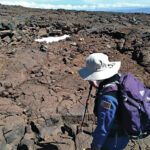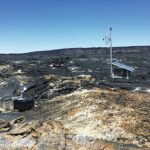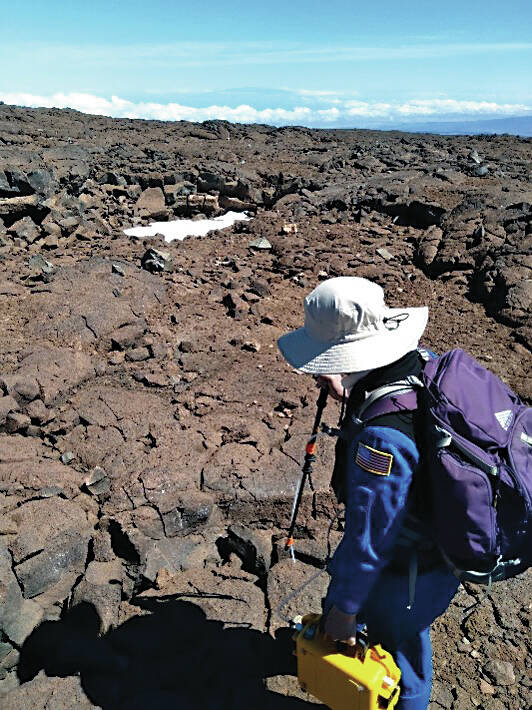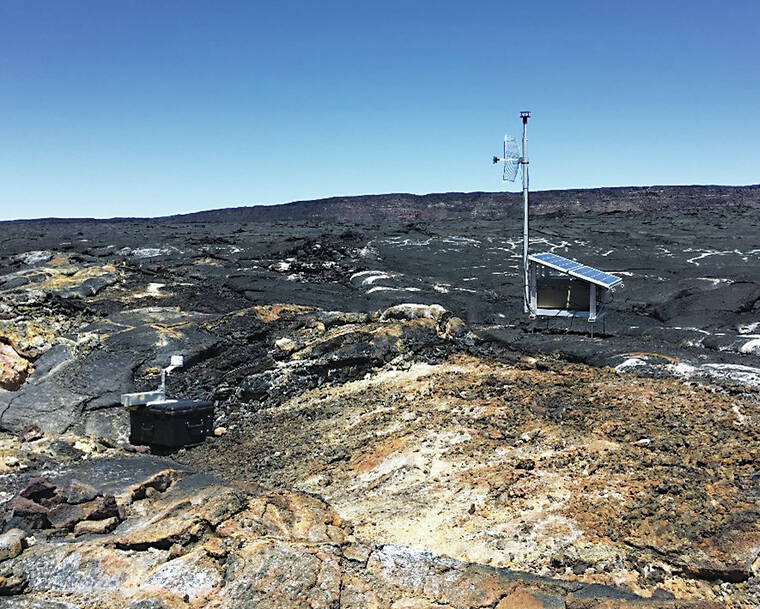When lava poured out over the floor of Moku‘aweoweo, Mauna Loa’s summit caldera, late on the night of November 27, 2022, it was still many hours away from infrastructure. Or most infrastructure.
The lava eventually blocked Mauna Loa NOAA observatory access road the next day, but well before it got there, it destroyed the Hawaiian Volcano Observatory’s (HVO’s) summit gas measuring station — less than ten minutes after the eruption began.
The station measured four gases — sulfur dioxide (SO2), carbon dioxide (CO2), hydrogen sulfide (H2S), and water vapor — as well as meteorological parameters including wind speed and fumarole (small gas vent) temperature. As part of HVO’s monitoring network, the station was installed to alert HVO of any changes in gas concentrations or the temperature at the site. Had the station survived, it would have given HVO a rich dataset regarding the chemistry of any eruptive gases blown toward it.
CO2 in particular can be indicative of deep magma recharge, either before or after an eruption.
For example, at Kilauea, a decrease in the proportion of CO2 relative to SO2 over a few months was a clue hinting at the eventual onset of Kilauea’s 2008-2018 summit eruption.
At Mauna Loa, the NOAA observatory has a long history of measuring atmospheric CO2. Volcanic CO2 is removed from their long-term atmospheric dataset, though that removed data can in turn be used to study Mauna Loa’s CO2 emissions.
A study published in 2001 by a NOAA observatory scientist — using data from the 1950s through the 1990s, which covers the periods after the 1950, the 1975, and the 1984 eruptions — showed that most CO2 there has been released after each of those eruptions.
That study also showed a small increase in CO2 emission from Mauna Loa in the 1990s, when there was no eruption. It’s possible that this CO2 pulse was related to a deep magma intrusion that didn’t make it to the surface.
There was no increase in CO2 emission detected before the 2022 eruption; however, based on the 2001 NOAA study, we might expect enhanced CO2 degassing now that the eruption is over.
Given the potential for anomalous CO2 emissions before, during and after eruptions, HVO is eager to replace the station at Mauna Loa summit as soon as possible.
However, before we can do that, we need to find a new suitable location.
The previous station was on the floor of Moku‘aweoweo, where we hoped that it might detect increased degassing before a new eruption, but that location clearly came with a lot of risks. The initial lava flows from the 2022 eruption destroying the station meant that we got no data from it during the ensuing two weeks of eruption.
This time, HVO is considering placing a station on the caldera rim, which is close enough to measure CO2 emitted from the caldera during favorable wind conditions and is a much safer spot. A new station there should survive future summit activity and give us gas data throughout eruptions.
Earlier in June, HVO gas scientists headed to Mauna Loa’s summit to begin searching for locations where gas might already be leaking out of the ground. They brought with them small, portable versions of the same gas sensors that are part of larger permanent monitoring stations. Visits to other summit locations are planned for later this summer as we continue the hunt for the best spot for the new station.
As you read this, you may be wondering how volcanic CO2 emissions like those at Mauna Loa and Kilauea compare to other sources of CO2, such as those from industry. Though volcanoes and their eruptions may seem like they should be big factors in the global CO2 budget, volcanoes release less than 1% of the CO2 emitted by human activities.
Although the amount of CO2 emitted by Mauna Loa may be small in a global view, it could still yield important clues about Mauna Loa’s volcanic processes and future eruptions. HVO hopes to find a location for the new gas monitoring station soon and have it installed in the coming months.
In the meantime, HVO does have a similar gas monitoring station high on Mauna Loa’s Southwest Rift Zone, as well as another at Kilauea summit. Even without our Mauna Loa summit station, we are still keeping an eye on our volcanoes and their degassing.
Volcano
activity updates
Kilauea’s eruption is paused. Its USGS Volcano Alert level is WATCH.
The summit eruption at Kilauea volcano — which has been confined to Halema‘uma‘u crater — remains paused since June 19. Earthquake activity in the summit region has been low over the past week. Summit tiltmeters tracked gradual inflation and deflation for much of the past week. A sulfur dioxide (SO2) emission rate of approximately 160 tonnes per day was measured on Thursday, June 22.
Mauna Loa is not erupting. Its USGS Volcano Alert Level is at NORMAL.
Webcams show no signs of activity on Mauna Loa. Seismicity remains low. Summit ground deformation rates indicate slow inflation as magma replenishes the reservoir system following the recent eruption. SO2 emission rates are at background levels.
There were two earthquakes with 3 or more felt reports in the Hawaiian Islands during the past week: a M3.1 earthquake 17 km (10 mi) WSW of Kailua-Kona at 32 km (20 mi) depth on June 28 at 4:45 p.m. HST and a M3.1 earthquake 3 km (2 mi) SSW of Pahala at 32 km (20 mi) depth on June 23 at 8:46 a.m. HST.
HVO continues to closely monitor Kilauea and Mauna Loa.
Please visit HVO’s website for past Volcano Watch articles, Kilauea and Mauna Loa updates, volcano photos, maps, recent earthquake information, and more. Email questions to askHVO@usgs.gov.
Volcano Watch is a weekly article and activity update written by U.S. Geological Survey Hawaiian Volcano Observatory scientists and affiliates.









